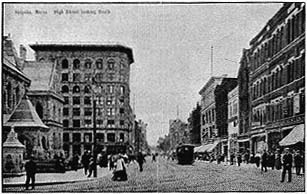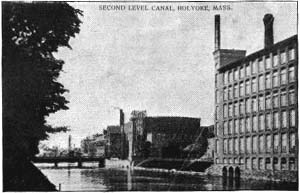|
Sketch of Holyoke by George H. Allyn, page 14 The Home National bank was organized in 1885, and located in Tilley's block, where McAuslan & Wakelin now are, not on the corner, which the latter purchased of Mrs. Wolcott. The People's Savings bank was organized at practically the same time. Later, in 1902, the bank removed to its present location, accompanied by the savings bank. Some internecine financial war resulted in E.L. Munn's withdrawing in 1892 and organizing the Park National bank, which located in the Hubbard & Taber block, on the site of which J.R. Smith's building now stands. This was the third national bank organized by Mr. Munn in Holyoke. The Holyoke Co-operative bank was also organized in 1880, and the City Co-operative in 1889. The Whiting Street reservoir was built in 1888, and was another good Delaney job, although John Delaney had passed away. John Delaney had accumulated a fortune largely since 1874, when his dam at Florence stood while all others were swept away like straw before the Mill River flood. Mr. Delaney's character and personality were interwoven in that dam as in other work, and it stood the supreme test. The George R. Dickinson Paper Company and the American Pad Company had been established, the D. Mackintosh & Sons mills had reached a high pitch of prosperity, and Holyoke entered the 90's under a full head of steam. One unpleasant experience was the establishment of the Keating Wheel Company, which was established in the Mosher (afterward Whitcomb) building, near the first level canal, and for stock in which Holyoke people passed out the long green in bunches. The investors never saw a cent, and Mr. Keating removed to Middletown, Conn., where it is reported the venture also was a failure. Another shock was the failure of the Winona Paper Company, in 1891. This mill had been dubbed the "slaughter house" by other expert paper men because of the loose methods of manufacturing and selling, but B.F. Hosford, the treasurer, always kept a big bank balance, and anyone who saw him driving about with his superb equipage would set him down for a millionaire at least. In contrast with these concerns were the splendid Coburn Trolley Track Company and the Syms & Dudley Paper Company, both of which Holyoke lost, the latter in 1892 removing to Michigan (W.F. Whiting buying R.S. Syms' splendid new residence on Linden street), and the Coburn Trolley Company going to Willimansett in 1899-1900. The Coburn Trolley's removal was due to the impossibility of getting a large tract of land in Holyoke at a reasonable figure, and we may believe that if W. A. Chase had retained the management of the Water Power Company, this concern would now be located at South Holyoke.

High Street, Looking South.
The writer has omitted the fact of the Second Congregational Church's change of base to the corner of High and Appleton streets in 1885, when John Delaney built the Marble Block on the old site. P.B. Johnson, the church contractor, went "stone broke" on the job, and never fully recovered financially, we believe. The Second Baptist had also sold out on Main street to "Tim" Merrick, who later sold the Water Power Company, and came to their present location as did the Methodist Church a little later. Grace Chapel had been established, new Catholic churches built, etc., matters which the Rev. Mr. Robinson has fully noted in his account, and which the writer, always a poor churchman, can, therefore, pass over. Springdale had boomed with the street railway extension, and Ingleside Terrace was opened in 1893, getting the cars in 1894, to Springfield. It was in 1893 that the panic stunned Holyoke temporarily. Our French citizens were becoming foremost in enterprise and trade. P. Bonvouloir, the Laporte brothers, A.D. Durocher and many others besides those heretofore mentioned, had come to the front, but of particular moment was the entry of Louis A. LaFrance into the building business in 1891. Forming later a partnership with Gilbert Potvin he initiated a new era in apartment building. The panic of 1893 caught them hard, and made them "turn handsprings" financially, so that Mr. Potvin, already wealthy and conservative, retired, leaving Mr. LaFrance to campaign as the Napoleon of builders. It would be idle to recount the structures he has built, but though often criticised, he revolutionized the tenement system, with the net results that in Ward One and South Holyoke modern, up-to-date tenements can be had by the workingman for very little higher rental than the old wooden frame buildings commanded, or the brick blocks with the crudest comforts. Times there were during the last twenty years when it must have looked somewhat squally to Mr. LaFrance, but he had Rooseveltian nerve, strong backing, and today his position is impregnable. Mr. LaFrance and J.R. Smith are the only citizens who have the honor of owning eight-story buildings. Casper Ranger has also been a power in local and outside contracting for over twenty-five years. In 1895 the Street Railway Company extended their line to Mountain Park, and two or three years later the Mt. Tom road was built, and the Northampton extension made. In 1896 the South Hadley Center extension was laid, Mr. Loomis being reported as saying "it wouldn't pay for the grease on the wheels." The People's Street Railway Company had applied for a franchise upon about every street in the city in 1894, but W.S. has always had the confidence of our citizens, in spite of his occasional periods of wrath, and, though the aldermen granted the franchise, the promoters didn't spunk up courage to buck the redoubtable William. Fairview, Chicopee Falls, Chicopee Street, and Westfield came in later with Amherst connections, and Holyoke believes that she can give any other city in the country an exemplification of a model street railway. In 1896 the suit of the Lyman Mills for a reduction of taxes dragged its slow length along till about 1904, when it was settled in favor of the city. Mr. Dowd, the chairman of the board of assessors, was absolutely conscientious and just in believing that the strongest corporation, no more than the weakest citizen, should evade its tax. But it was unfortunate that he employed the late T.W. Mann, a most gifted engineer, but so unique in ideas and personality that it was impossible to get along with him. He sued the city for services, and we don't think the case was ever settled, though the auditor reported on it. It was back in the 80's that Mr. Mann contracted with the city for the assessors' maps, and the city strove for years to have him prepare them, in vain, though he did an enormous amount of field work. When he died, about 1907, there was thought to be a small gold mine in his incompleted maps.
 Second Level Canal, From Lyman Street.
| Previous Page | Next Page |
| People & Organizations | Allyn's Sketch of Holyoke |
| Selected Advertisments | Churches | Surname Index |
© Laurel O'Donnell 1996 - 2005, all rights reserved
This document may be downloaded for personal non-commercial use only and should not be reproduced or distributed without permission. |